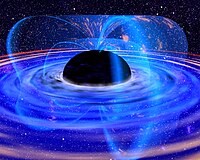
Photo from wikipedia
Massive black holes often exist within dwarf galaxies, and both simulations and observations have shown that a substantial fraction of these may be off-centre with respect to their hosts. We… Click to show full abstract
Massive black holes often exist within dwarf galaxies, and both simulations and observations have shown that a substantial fraction of these may be off-centre with respect to their hosts. We trace the evolution of off-centre massive black holes (MBHs) in dwarf galaxies using cosmological hydrodynamical simulations, and show that the reason for off-centre locations is mainly due to galaxy–galaxy mergers. We calculate dynamical time-scales and show that off-centre MBHs are unlikely to sink to their galaxys’ centres within a Hubble time, due to the shape of the hosts’ potential wells and low stellar densities. These wandering MBHs are unlikely to be detected electromagnetically, nor is there a measurable dynamical effect on the galaxy’s stellar population. We conclude that off-centre MBHs may be common in dwarfs, especially if the mass of the MBH is small or the stellar mass of the host galaxy is large. However, detecting them is extremely challenging, because their accretion luminosities are very low and they do not measurably alter the dynamics of their host galaxies.
Journal Title: Monthly Notices of the Royal Astronomical Society
Year Published: 2021
Link to full text (if available)
Share on Social Media: Sign Up to like & get
recommendations!